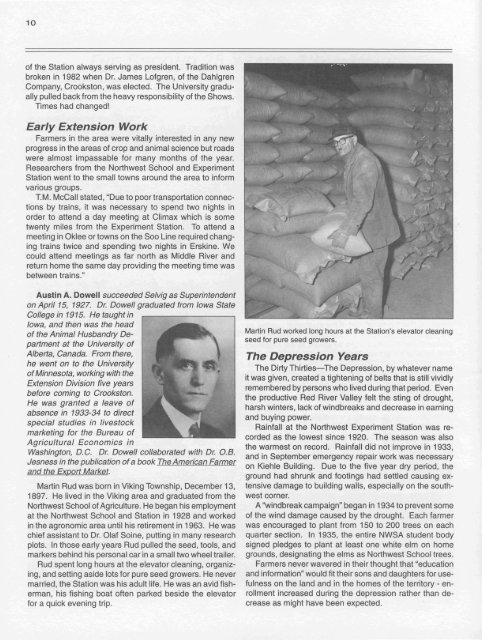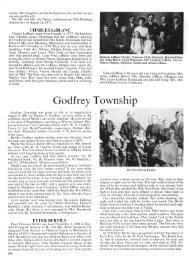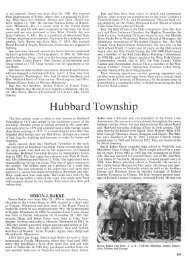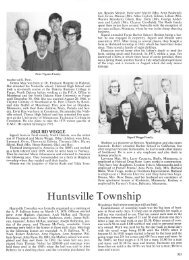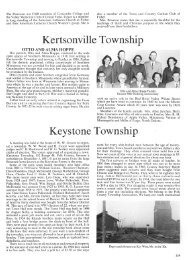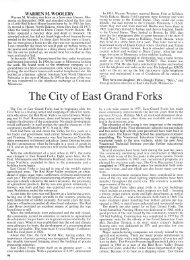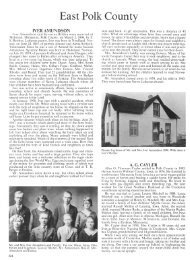Gleanings - to files - University of Minnesota
Gleanings - to files - University of Minnesota
Gleanings - to files - University of Minnesota
You also want an ePaper? Increase the reach of your titles
YUMPU automatically turns print PDFs into web optimized ePapers that Google loves.
10<br />
<strong>of</strong> the Station always serving as president. Tradition was<br />
broken in 1982 when Dr. James L<strong>of</strong>gren, <strong>of</strong> the Dahlgren<br />
Company, Crooks<strong>to</strong>n, was elected. The <strong>University</strong> gradually<br />
pulled back from the heavy responsibility <strong>of</strong> the Shows.<br />
Times had changed!<br />
Early Extension Work<br />
Farmers in the area were vitally interested in any new<br />
progress in the areas <strong>of</strong> crop and animal science but roads<br />
were almost impassable for many months <strong>of</strong> the year.<br />
Researchers from the Northwest School and Experiment<br />
Station went <strong>to</strong> the small <strong>to</strong>wns around the area <strong>to</strong> inform<br />
various groups.<br />
T.M. McCall stated, "Due <strong>to</strong> poor transportation connections<br />
by trains, it was necessary <strong>to</strong> spend two nights in<br />
order <strong>to</strong> attend a day meeting at Climax which is some<br />
twenty miles from the Experiment Station. To attend a<br />
meeting in Oklee or <strong>to</strong>wns on the Soo Line required changing<br />
trains twice and spending two nights in Erskine. We<br />
could attend meetings as far north as Middle River and<br />
return home the same day providing the meeting time was<br />
between trains."<br />
Austin A. Dowell succeeded Selvig as Superintendent<br />
on April 15, 1927. Dr. Dowell graduated from Iowa State<br />
College in 1915. He taught in<br />
Iowa, and then was the head<br />
<strong>of</strong> the Animal Husbandry Department<br />
at the <strong>University</strong> <strong>of</strong><br />
Alberta, Canada. From there,<br />
he went on <strong>to</strong> the <strong>University</strong><br />
<strong>of</strong><strong>Minnesota</strong>, working with the<br />
Extension Division five years<br />
before coming <strong>to</strong> Crooks<strong>to</strong>n.<br />
He was granted a leave <strong>of</strong><br />
absence in 1933-34 <strong>to</strong> direct<br />
special studies in lives<strong>to</strong>ck<br />
marketing for the Bureau <strong>of</strong><br />
Agricultural Economics in<br />
Washing<strong>to</strong>n, D.C. Dr, Dowell collaborated with Dr. 0.8.<br />
Jesness in the pUblication <strong>of</strong>a book The American Farmer<br />
and the Export Market.<br />
Martin Rud was born in Viking Township, December 13,<br />
1897. He lived in the Viking area and graduated from the<br />
Northwest School <strong>of</strong> Agriculture. He began his employment<br />
at the Northwest School and Station in 1928 and worked<br />
in the agronomic area until his retirement in 1963. He was<br />
chief assistant <strong>to</strong> Dr. Olaf Soine, putting in many research<br />
plots. In those early years Rud pulled the seed, <strong>to</strong>ols, and<br />
markers behind his personal car in a small two wheel trailer.<br />
Rud spent long hours at the eleva<strong>to</strong>r cleaning, organizing,<br />
and setting aside lots for pure seed growers. He never<br />
married, the Station was his adult life. He was an avid fisherman,<br />
his fishing boat <strong>of</strong>ten parked beside the eleva<strong>to</strong>r<br />
for a qUick evening trip.<br />
Martin Aud worked long hours at the Station's eleva<strong>to</strong>r cleaning<br />
seed for pure seed growers.<br />
The Depression Years<br />
The Dirty Thirties-The Depression, by whatever name<br />
it was given, created a tightening <strong>of</strong> belts that is still vividly<br />
remembered by persons who lived during that period. Even<br />
the productive Red River Valley felt the sting <strong>of</strong> drought,<br />
harsh winters, lack <strong>of</strong> windbreaks and decrease in earning<br />
and buying power.<br />
Rainfall at the Northwest Experiment Station was recorded<br />
as the lowest since 1920. The season was also<br />
the warmest on record. Rainfall did not improve in 1933,<br />
and in September emergency repair work was necessary<br />
on Kiehle Building. Due <strong>to</strong> the five year dry period, the<br />
ground had shrunk and footings had settled causing extensive<br />
damage <strong>to</strong> building walls, especially on the southwest<br />
corner.<br />
A ''windbreak campaign" began in 1934 <strong>to</strong> prevent some<br />
<strong>of</strong> the wind damage caused by the drought. Each farmer<br />
was encouraged <strong>to</strong> plant from 150 <strong>to</strong> 200 trees on each<br />
quarter section. In 1935, the entire NWSA student body<br />
signed pledges <strong>to</strong> plant at least one white elm on home<br />
grounds, designating the elms as Northwest School trees.<br />
Farmers never wavered in their thought that "education<br />
and information" would fit their sons and daughters for usefulness<br />
on the land and in the homes <strong>of</strong> the terri<strong>to</strong>ry - enrollment<br />
increased during the depression rather than decrease<br />
as might have been expected.


